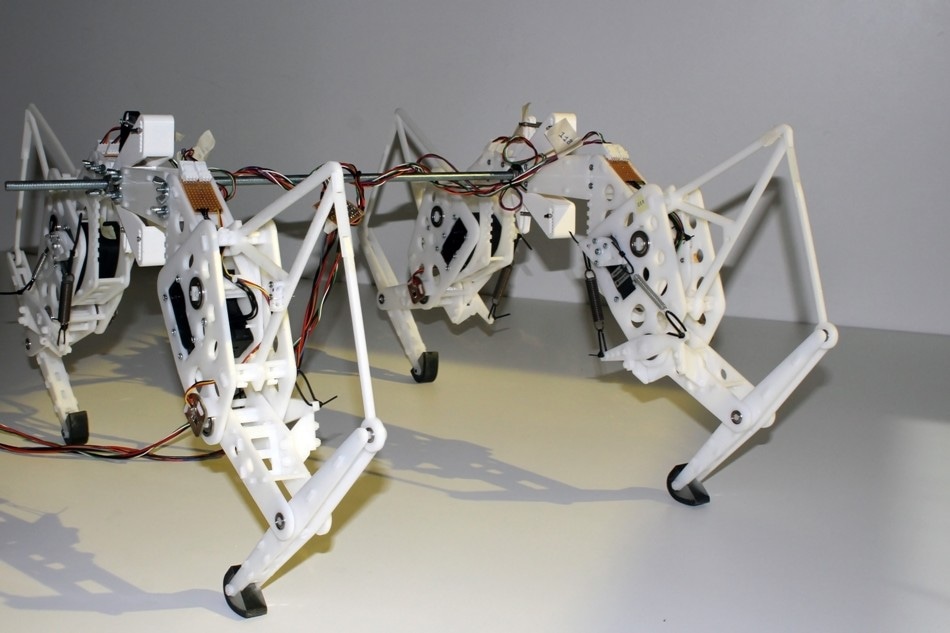Apr 20 2017
 Cheeta robot (Credit: University of Twente)
Cheeta robot (Credit: University of Twente)
A prototype cheetah robot has been developed by Geert Folkertsma, a researcher from the University of Twente. Folkertsma spent four years of research and development to come up with a scaled-down robotic version of the fastest land animal to be found in the world, aiming to replicate its movements.
The robot actually moves using only about 15% more energy when compared to a real cheetah.
Folkertsma’s doctoral defense of this unique project has been scheduled on 21 April 2017 at the University of Twente.
As you might expect of the fastest land animal in the world, the cheetah makes very efficient use of its energy. I wanted to create a robot that runs the same way, with the aim of applying this knowledge to the development of new robots. Robots are bound to play an increasingly important part in our daily lives and we therefore have to ensure that they can move effectively in our environment. My robot vacuum cleaner, for example, cannot climb stairs or even cope with thresholds. We therefore need to develop robots that can walk and when it comes to moving around efficiently, there’s a lot we can learn from the cheetah.
Geert Folkertsma, Researcher, University of Twente
Useful Applications
The cheetah runs smoothly and swiftly, while walking robots tend to be heavy and large, taking cumbersome steps that in fact use an increased amount of energy. “By applying knowledge about the movement patterns of the cheetah, you can develop robots that walk more elegantly and above all efficiently,” Folkertsma continues. The valuable knowledge provided by Folkertsma’s research can be used to improve the robots of the future, designed in a manner that allows them to extend their support in areas like housekeeping or healthcare. This knowledge can also be used in advanced prosthetics that are equipped with robotics or rehabilitation robots.
Research
Extensive video footage of cheetahs was studied by Folkertsma, and he also used software to further analyze their movements. The backbone plays a significant role to the power produced by this big cat. The cheetah runs exceptionally fast and takes huge leaps to move efficiently by bending and expanding its spine. “The main difference between existing walking robots and my cheetah robot is therefore the backbone,” Folkertsma says. “The trick was to imitate it without complicating matters unnecessarily: instead of vertebrae and intervertebral discs, we worked with a cleverly placed spring which delivers approximately the same effect. Cheetahs are also able to store a lot of energy in their muscles for later use. This too is something we have imitated by fitting carefully selected springs in our robot’s legs.”
Results
My robot can be seen as a simulated skeleton, complete with muscles and joints. Not every element is where you would find it in the animal, but the spine, shoulders and hips occupy the same position. A real cheetah not only runs, but also climbs trees for example. That is not something our robot needs to copy. After all, the aim was not to reconstruct a cheetah, but to reap the rewards of its efficient way of running. By way of illustration, the robot does not have a normal foot, but a light-weight mechanism with springs which turned out to be more efficient.
Geert Folkertsma, Researcher, University of Twente
Folkertsma has delivered a prototype weighing 2.5 kg with a length of 30 cm: four times smaller than a real cheetah and twenty times lighter. Considering the weight difference, the robot moves using just 15% more energy than a real cheetah. Currently, the robot can reach a speed of about 1 km per hour. “That’s quite a pace for such a small robot,” Folkertsma observes. “More research is needed to enable it to run as fast as a real cheetah, relatively speaking. That would entail getting up to a speed of around twenty kilometres per hour. A Master’s student is currently working on a newly developed robotic leg and the first tests, focusing on a single leg, are already promising. With four legs of this type, the robot will be able to run much faster; I think this will help us make genuine advances.”
PhD Defense
On 21 April, Geert Folkertsma will defend his PhD thesis entitled Energy-based and biomimetic robotics in the Prof. G. Berkhoff hall, in the Waaier Building on the University of Twente campus at 16.45. He conducted his doctoral research, under the supervision of Prof. Stefano Stramigioli, at the Department of Robotics and Mechatronics (RAM).